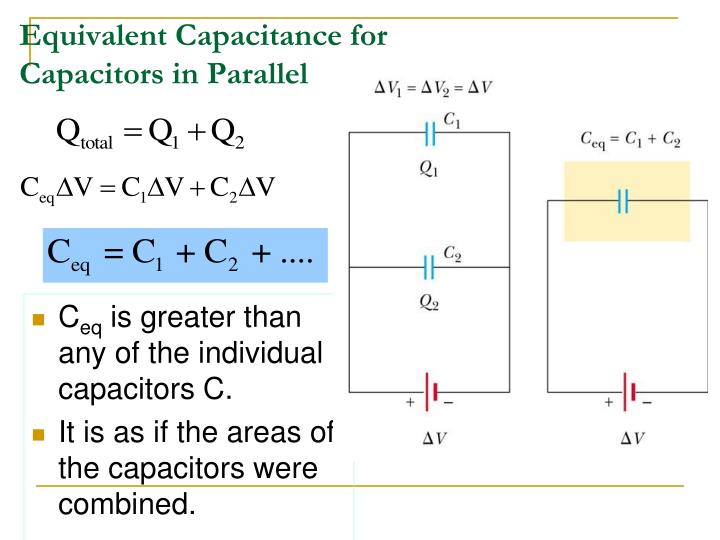

So we're going to add these 2 capacitors in parallel and I want to determine what is the total charge if the potential difference across these capacitors is 6 volts.Īlright let's do it 2 different ways, if the potential difference is 6 volts then it must be the potential difference across the 3 Farad capacitor so that means that the charge held on the 3 Farad capacitor is going to be potential difference times capacitance 18 joules. And this was actually used a lot in the early construction of computers you would put a bunch of capacitors in parallel and then you'd be able to get a much bigger capacitance that you could get any other way. It's just like resistors in series, so if I add more capacitors in parallel then the capacitance is going to increase. So that means all I have to do is just add which is always nice.
#Capacitors in parallel plus
And that gives us a wonderfully simple formula where adding capacitors in parallel, c parallel just equals c1 plus c2. Alright so let's look and see what happens, q equals q1 plus q2 so since q is equal to capacitance times potential difference we write c parallel delta v equals c1 delta v plus c2 delta v potential difference is the same so delta v cancels. Because as I try to charge c parallel all the charge that I put either on c1 or on c2 went onto cp.Īlright so charge adds, potential difference is the same. So the idea is that if I want just one effective capacitor c parallel, to represent this parallel combination the charge that I should put on c parallel is going to be the sum of these 2 charges. Alright so the potential difference is going to be the same like always is the case, with parallel combinations but the charge is going to add. So it can charge up this capacitor or it could charge up that one. So we'll write a parallel combination of capacitors just like this, so if I start charging this combination by sending some charge in here, that charge can go in 2 different branches. Now when we're talking about capacitors instead of talking about the current having a choice we talk about the charge having a choice. Now as we all know parallel means that the current has a choice.
#Capacitors in parallel series
When a charge Q in a series circuit is removed from a plate of the first capacitor (which we denote as ), it must be placed on a plate of the second capacitor (which we denote as and so on.Alright so let's talk about adding capacitors in parallel.

This occurs due to the conservation of charge in the circuit.

Charge on this equivalent capacitor is the same as the charge on any capacitor in a series combination: That is, all capacitors of a series combination have the same charge. Generally, any number of capacitors connected in series is equivalent to one capacitor whose capacitance (called the equivalent capacitance) is smaller than the smallest of the capacitances in the series combination. The series combination of two or three capacitors resembles a single capacitor with a smaller capacitance. However, the potential drop on one capacitor may be different from the potential drop on another capacitor, because, generally, the capacitors may have different capacitances.

Charges are then induced on the other plates so that the sum of the charges on all plates, and the sum of charges on any pair of capacitor plates, is zero. To explain, first note that the charge on the plate connected to the positive terminal of the battery is and the charge on the plate connected to the negative terminal is. When this series combination is connected to a battery with voltage V, each of the capacitors acquires an identical charge Q. As for any capacitor, the capacitance of the combination is related to the charge and voltage by using (Figure). (Figure) illustrates a series combination of three capacitors, arranged in a row within the circuit.


 0 kommentar(er)
0 kommentar(er)
